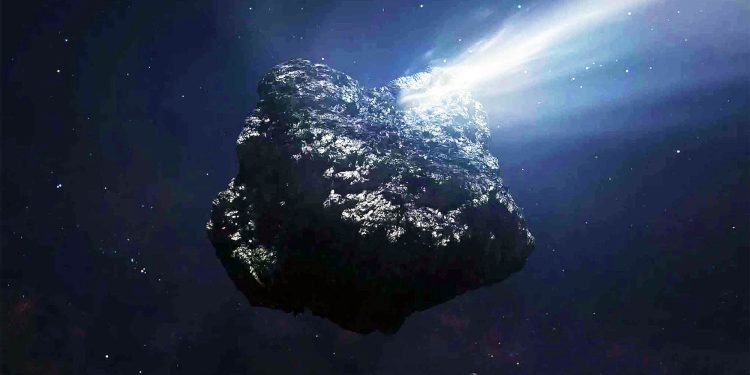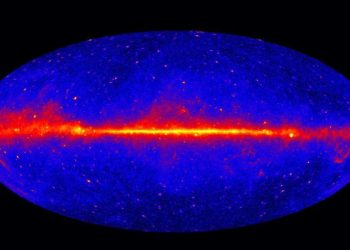Astronomers report a detailed analysis of the largest Oort Cloud comet ever detected – “C 2014 UN271”. Carbon monoxide escapes from its surface while it is still more than a billion kilometers from the Sun.
Comet C 2014 UN271, also called “Bernardinelli Bernstein”. It is active at a distance where most comets should be silent, or so it was believed.
Nathan X. Roth, a planetary scientist at NASA’s Goddard Space Flight Center, led the team behind this remarkable discovery.
Using the Atacama Large Millimeter/submillimeter Array (ALMA), a powerful array of 66 radio antennas that observe invisible light from cold gases and dust, his group focused on the comet long before it approached the inner solar system.
They observed it from more than a billion miles away, in a region where sunlight is weak and temperatures are hundreds of degrees below zero.
Even in this extreme cold, they detected explosions of gas escaping from its frozen surface, evidence that the largest known comet is far from dormant.
Why C 2014 UN271 is special
This comet is approximately 85 miles wide, making it larger than many small towns. Previous measurements showed a core 137 ± 17 kilometers in diameter and a dark, comet-like surface.
It comes from the Oort Cloud, a distant shell of icy bodies that surrounds the solar system. Objects in this region spend most of their time far from the Sun, so they tend to be chemically primitive.
According to a peer-reviewed study, ALMA detected jets of carbon monoxide 16.6 astronomical units from the Sun, or about 1.54 billion miles.
The gas appears in the radio spectrum as a sharp signal at 230 gigahertz that cannot be confused with noise.
The data reveals several jets that changed between observations separated by days. This tells us that the core has active regions and perhaps rotation that causes vents of sunlight to flow in and out.
Why distant comets wake up
At these distances, the water ice remains frozen, locked beneath the comet’s surface like a rock.
Rather, the activity is driven by more volatile ices such as carbon monoxide and carbon dioxide, which can vaporize in much weaker sunlight.
These gases escape through cracks in the surface, creating gentle jets that push dust outward and form a thin atmosphere called a coma around the core.
Even a small amount of warming can trigger this process, showing that comets can come to life long before they enter the warmer regions near Jupiter or Mars.
Measure C 2014 UN271
The team observed a compact coma, a hazy atmosphere around the core, and jets of carbon monoxide that extended far from the central source.
They also set a strict upper limit for formaldehyde, a simple organic molecule composed of carbon, hydrogen and oxygen, which helps rule out coma chemistry as the main source of the gas and indicates escape from the surface.
The radio signal also carries thermal information, which makes it possible to estimate the dust near the core. The thermal emission corresponded to a large cold body and a small amount of dust close to the core.
“These measurements give us insight into how this enormous, icy world works. We observe explosive outgassing patterns that raise new questions about how this comet will evolve as it continues its journey toward the inner solar system,” Roth added.
The quote sums up the scientific surprise. The comet dissipates long before the water ice can take over, revealing that frozen gases buried deep inside can become active even in the darkest reaches of the solar system.
C 2014 UN271 surprisingly active
These observations offer a clear look at the raw materials that built the planets. Molecules like carbon monoxide may hold clues to the early solar system that water-rich comets closer to the Sun might have lost.
They also help explain how such a large body can remain active over long distances. Knowing the trigger for distant activity refines models of comet evolution.
ALMA used spectroscopy, the measurement of light at very specific frequencies, to detect carbon monoxide in the faint background. The accuracy is high enough to see tiny frequency changes that show how fast the gas is moving.
The telescope’s resolution also allows astronomers to map the direction of the jets. This combination of speed and position paints a dynamic picture of the vents.
Where is C 2014 UN271 heading?
This comet will make its closest passage to the Sun, called perihelion, on January 29, 2031, at a distance of approximately 10.9 astronomical units, or a little beyond the orbit of Saturn. As it gets closer, the sunlight will become stronger and more types of ice will begin to turn into gas.
Scientists expect to see new materials like methane and carbon dioxide begin to escape, giving them the opportunity to observe how the comet changes step by step as it heats up during its long journey inward.
Future observations will look for carbon dioxide and other volatiles as sunlight increases. If these species activate, the gas balance will change and the coma will change shape.
The team’s methods allow this object to be compared with other objects in the Oort Cloud, a vast spherical region of icy bodies that surrounds the solar system and marks its outermost boundary.
Careful, repeatable measurements will tell us whether this giant is typical or aberrant.
Much more to learn about comets
The confirmed size from ALMA’s previous work matches the new thermal data. This consistency strengthens the hypothesis that we are seeing the largest known active comet from the distant reservoir beyond the planets.
The changing jets show that even very cold comets are not static. They respond to sunlight in complex ways, and this behavior can now be precisely measured.
A comet this big and this far away is not supposed to be this alive. Yet radio data proves that physics doesn’t wait for water to boil.
Careful observations, clear definitions, and solid evidence allow scientists to distinguish signals from hype. This is how a distant point becomes a detailed story about chemistry and time.
The study is published in Letters from the astrophysical journal.
—–
Do you like what you read? Subscribe to our newsletter for engaging articles, exclusive content and the latest updates.
Check us out on EarthSnap, a free app brought to you by Eric Ralls and Earth.com.
—–









